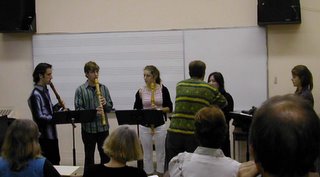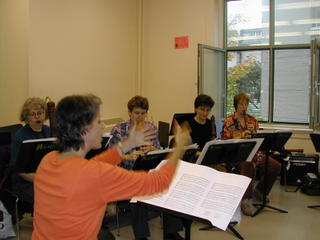Les Voix humaines: Dowland
After a lapse due to home renovations, I can once again take time to reflect on the many musical events I hear in Montreal. The new year is off to a great start. Music in the crypt. Dowland - that melancholy man - wrote music that suits the atmosphere of the dark room. The only light in the crypt came from the lamps which lit the music for the performers as well as some candles. The atmosphere was sombre and yet warm at the same time.
The Seven Lachrimae were interspersed with more cheerful galliards and poetry in both English and French recited by Sean McCutcheon and François Filliatrault. Les Voix humaines - now 5 viols (Susie Napper, Margaret Little, Elin Soderstrom, Melisonde Corriveau and Jivko Georgiev). and joined by lutenist, Sylvain Bergeron, have a warm blended sound. Lute with viols provided a nice contrast - the plucked strings vs the bowed. The acoustics in the crypt are wonderful. In this small space you can almost feel the vibration of the strings.
The concert was short, - too short. I wanted the music to continue to weave its magic. But Susie Napper continued to astonish us with a snack following the concert - delicacies prepared in her kitchen. Many chefs would be envious of her culinary ability.
The Seven Lachrimae were interspersed with more cheerful galliards and poetry in both English and French recited by Sean McCutcheon and François Filliatrault. Les Voix humaines - now 5 viols (Susie Napper, Margaret Little, Elin Soderstrom, Melisonde Corriveau and Jivko Georgiev). and joined by lutenist, Sylvain Bergeron, have a warm blended sound. Lute with viols provided a nice contrast - the plucked strings vs the bowed. The acoustics in the crypt are wonderful. In this small space you can almost feel the vibration of the strings.
The concert was short, - too short. I wanted the music to continue to weave its magic. But Susie Napper continued to astonish us with a snack following the concert - delicacies prepared in her kitchen. Many chefs would be envious of her culinary ability.





